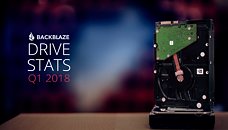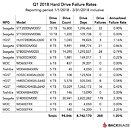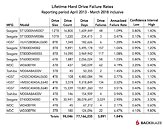Wednesday, May 2nd 2018
Backblaze Releases Q1 2018 Hard Drive Longevity, Reliability Stats
As of March 31, 2018 we had 100,110 spinning hard drives. Of that number, there were 1,922 boot drives and 98,188 data drives. This review looks at the quarterly and lifetime statistics for the data drive models in operation in our data centers. We'll also take a look at why we are collecting and reporting 10 new SMART attributes and take a sneak peek at some 8 TB Toshiba drives. Along the way, we'll share observations and insights on the data presented and we look forward to you doing the same in the comments.Background
Since April 2013, Backblaze has recorded and saved daily hard drive statistics from the drives in our data centers. Each entry consists of the date, manufacturer, model, serial number, status (operational or failed), and all of the SMART attributes reported by that drive. Currently there are about 97 million entries totaling 26 GB of data. You can download this data from our website if you want to do your own research, but for starters here's what we found.
Hard Drive Reliability Statistics for Q1 2018
At the end of Q1 2018 Backblaze was monitoring 98,188 hard drives used to store data. For our evaluation below we remove from consideration those drives which were used for testing purposes and those drive models for which we did not have at least 45 drives. This leaves us with 98,046 hard drives. The table below covers just Q1 2018.Notes and Observations
If a drive model has a failure rate of 0%, it only means there were no drive failures of that model during Q1 2018. The overall Annualized Failure Rate (AFR) for Q1 is just 1.2%, well below the Q4 2017 AFR of 1.65%. Remember that quarterly failure rates can be volatile, especially for models that have a small number of drives and/or a small number of Drive Days.
There were 142 drives (98,188 minus 98,046) that were not included in the list above because we did not have at least 45 of a given drive model. We use 45 drives of the same model as the minimum number when we report quarterly, yearly, and lifetime drive statistics.
Welcome Toshiba 8TB drives, almost…
We mentioned Toshiba 8 TB drives in the first paragraph, but they don't show up in the Q1 Stats chart. What gives? We only had 20 of the Toshiba 8 TB drives in operation in Q1, so they were excluded from the chart. Why do we have only 20 drives? When we test out a new drive model we start with the "tome test" and it takes 20 drives to fill one tome. A tome is the same drive model in the same logical position in each of the 20 Storage Pods that make up a Backblaze Vault. There are 60 tomes in each vault.
In this test, we created a Backblaze Vault of 8 TB drives, with 59 of the tomes being Seagate 8 TB drives and 1 tome being the Toshiba drives. Then we monitored the performance of the vault and its member tomes to see if, in this case, the Toshiba drives performed as expected.So far the Toshiba drive is performing fine, but they have been in place for only 20 days. Next up is the "pod test" where we fill a Storage Pod with Toshiba drives and integrate it into a Backblaze Vault comprised of like-sized drives. We hope to have a better look at the Toshiba 8 TB drives in our Q2 report - stay tuned.
Lifetime Hard Drive Reliability Statistics
While the quarterly chart presented earlier gets a lot of interest, the real test of any drive model is over time. Below is the lifetime failure rate chart for all the hard drive models which have 45 or more drives in operation as of March 31st, 2018. For each model, we compute their reliability starting from when they were first installed.Notes and Observations
The failure rates of all of the larger drives (8-, 10- and 12 TB) are very good, 1.2% AFR (Annualized Failure Rate) or less. Many of these drives were deployed in the last year, so there is some volatility in the data, but you can use the Confidence Interval to get a sense of the failure percentage range.
The overall failure rate of 1.84% is the lowest we have ever achieved, besting the previous low of 2.00% from the end of 2017.
Our regular readers and drive stats wonks may have noticed a sizable jump in the number of HGST 8 TB drives (model: HUH728080ALE600), from 45 last quarter to 1,045 this quarter. As the 10 TB and 12 TB drives become more available, the price per terabyte of the 8 TB drives has gone down. This presented an opportunity to purchase the HGST drives at a price in line with our budget.
We purchased and placed into service the 45 original HGST 8 TB drives in Q2 of 2015. They were our first Helium-filled drives and our only ones until the 10 TB and 12 TB Seagate drives arrived in Q3 2017. We'll take a first look into whether or not Helium makes a difference in drive failure rates in an upcoming blog post.
New SMART Attributes
If you have previously worked with the hard drive stats data or plan to, you'll notice that we added 10 more columns of data starting in 2018. There are 5 new SMART attributes we are tracking each with a raw and normalized value:
Yes, SSD drives, but before you jump to any conclusions, we used 10 Samsung 850 EVO SSDs as boot drives for a period of time in Q1. This was an experiment to see if we could reduce boot up time for the Storage Pods. In our case, the improved boot up speed wasn't worth the SSD cost, but it did add 10 new columns to the hard drive stats data.
Source:
Backblaze
Since April 2013, Backblaze has recorded and saved daily hard drive statistics from the drives in our data centers. Each entry consists of the date, manufacturer, model, serial number, status (operational or failed), and all of the SMART attributes reported by that drive. Currently there are about 97 million entries totaling 26 GB of data. You can download this data from our website if you want to do your own research, but for starters here's what we found.
Hard Drive Reliability Statistics for Q1 2018
At the end of Q1 2018 Backblaze was monitoring 98,188 hard drives used to store data. For our evaluation below we remove from consideration those drives which were used for testing purposes and those drive models for which we did not have at least 45 drives. This leaves us with 98,046 hard drives. The table below covers just Q1 2018.Notes and Observations
If a drive model has a failure rate of 0%, it only means there were no drive failures of that model during Q1 2018. The overall Annualized Failure Rate (AFR) for Q1 is just 1.2%, well below the Q4 2017 AFR of 1.65%. Remember that quarterly failure rates can be volatile, especially for models that have a small number of drives and/or a small number of Drive Days.
There were 142 drives (98,188 minus 98,046) that were not included in the list above because we did not have at least 45 of a given drive model. We use 45 drives of the same model as the minimum number when we report quarterly, yearly, and lifetime drive statistics.
Welcome Toshiba 8TB drives, almost…
We mentioned Toshiba 8 TB drives in the first paragraph, but they don't show up in the Q1 Stats chart. What gives? We only had 20 of the Toshiba 8 TB drives in operation in Q1, so they were excluded from the chart. Why do we have only 20 drives? When we test out a new drive model we start with the "tome test" and it takes 20 drives to fill one tome. A tome is the same drive model in the same logical position in each of the 20 Storage Pods that make up a Backblaze Vault. There are 60 tomes in each vault.
In this test, we created a Backblaze Vault of 8 TB drives, with 59 of the tomes being Seagate 8 TB drives and 1 tome being the Toshiba drives. Then we monitored the performance of the vault and its member tomes to see if, in this case, the Toshiba drives performed as expected.So far the Toshiba drive is performing fine, but they have been in place for only 20 days. Next up is the "pod test" where we fill a Storage Pod with Toshiba drives and integrate it into a Backblaze Vault comprised of like-sized drives. We hope to have a better look at the Toshiba 8 TB drives in our Q2 report - stay tuned.
Lifetime Hard Drive Reliability Statistics
While the quarterly chart presented earlier gets a lot of interest, the real test of any drive model is over time. Below is the lifetime failure rate chart for all the hard drive models which have 45 or more drives in operation as of March 31st, 2018. For each model, we compute their reliability starting from when they were first installed.Notes and Observations
The failure rates of all of the larger drives (8-, 10- and 12 TB) are very good, 1.2% AFR (Annualized Failure Rate) or less. Many of these drives were deployed in the last year, so there is some volatility in the data, but you can use the Confidence Interval to get a sense of the failure percentage range.
The overall failure rate of 1.84% is the lowest we have ever achieved, besting the previous low of 2.00% from the end of 2017.
Our regular readers and drive stats wonks may have noticed a sizable jump in the number of HGST 8 TB drives (model: HUH728080ALE600), from 45 last quarter to 1,045 this quarter. As the 10 TB and 12 TB drives become more available, the price per terabyte of the 8 TB drives has gone down. This presented an opportunity to purchase the HGST drives at a price in line with our budget.
We purchased and placed into service the 45 original HGST 8 TB drives in Q2 of 2015. They were our first Helium-filled drives and our only ones until the 10 TB and 12 TB Seagate drives arrived in Q3 2017. We'll take a first look into whether or not Helium makes a difference in drive failure rates in an upcoming blog post.
New SMART Attributes
If you have previously worked with the hard drive stats data or plan to, you'll notice that we added 10 more columns of data starting in 2018. There are 5 new SMART attributes we are tracking each with a raw and normalized value:
- 177 - Wear Range Delta
- 179 - Used Reserved Block Count Total
- 181- Program Fail Count Total or Non-4K Aligned Access Count
- 182 - Erase Fail Count
- 235 - Good Block Count AND System(Free) Block Count
Yes, SSD drives, but before you jump to any conclusions, we used 10 Samsung 850 EVO SSDs as boot drives for a period of time in Q1. This was an experiment to see if we could reduce boot up time for the Storage Pods. In our case, the improved boot up speed wasn't worth the SSD cost, but it did add 10 new columns to the hard drive stats data.




35 Comments on Backblaze Releases Q1 2018 Hard Drive Longevity, Reliability Stats
Also, always fun to make a personal bet with myself as to who will be the first to jump out with "These tests are useless/meaningless/stoopid!!!"
I bought the ''best '' and sometimes it may last and work well and sometimes it don't at all I bought el'chepo no brand stuff and got great time and service from it .
like I get 4 WD black drives and maybe 2 of the 4 give good service and long term use or 2 referb whoevers drives for 19 bucks for Linux that after 10 years are still going .
like I said a few tims its all now cheap made in china junk and buyer beware on everything . you either get a good one or the lemon [opinion] .
Strictly speaking I don't necessarily care if a HDD fails but I care if I lose my data. So RAID arrays and backups with secondary RAID arrays is what I rely on. Those do need to be fed with drives though and good quality ones at that.
I'm using WD Red drives (3TB, 4TB and 8TB but mostly 8TB) which have held up fairly well so far over the years. Unfortunately I don't see those listed but I guess the HGST 8TB drives are the closest to the WD Red 8TB.
''On October 19, 2015, Western Digital Corporation announced a decision from China's Ministry of Commerce ("MOFCOM") which enabled the company to integrate substantial portions of its HGST and WD subsidiaries under Western Digital Corporation ("Western Digital"), but they must offer both HGST and WD product brands in the market and maintain separate sales teams for two years from the date of the decision
''October 19, 2015, HGST is a Western Digital brand, and no longer a separate entity''
Its like taking a normal family car without any modifications and driving it through the sahara desert and when the car obviously fails due to the heat sand and the rough going you blame it all on the car and not the idiot who took it into the desert in the first place
All of the numbers needs to be taken with a large grain of salt as they dont represents the whole picture
From my personal experience, hard drives at home, in general, last over a decade easily, except for the external drives that have literally been tossed around.
I am still buying them for storage of unimportant data using RAID 1 given their price, but anything further I am using HGST if not WD Gold.
These backblaze numbers give no useful information to normal consumers, and people really need to stop posting them here.
At the end of the day, the model of the drive is what matters, not the brand.
Sure there's the set of 15k and 5k HGST drives that follow the trend, but aside from that the numbers of WD drives they are reporting are in my mind too low to draw any conclusions, if anything they suggest that the WD red drives are actually crap :D
I had a WD Red fail in the same time frame and that was a brand new drive so this data from Backblaze is really not very useful and again dont tell the whole story
Seagate by the way has improved a lot these past few years and their more expensive drives are nothing like the crap they had years ago
An Ironwolf Pro is no worse then a WD Red Pro from my experience
But those failure rates are a side effect of what they consider a failure, and the fact that what they consider a failed drive is not a failed drive to a normal user.(Which is another reason these numbers are pretty useless to most people.)Even if you use their data, I don't see how you come to that conclusion. Their top 5 worst drives are WD, WD, Seagate, WD, Toshiba.
I mean, there are 3 WD drives on their lifetime chart, and two of those drives have the 1st and 2nd worst failure rates, and the third WD drive is the 4th worst failure rate.
None of them have failed. None of them have any SMART errors.